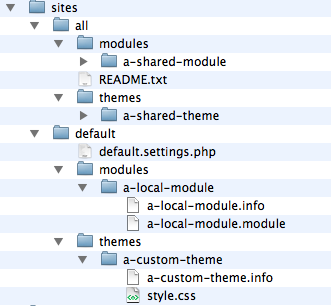Drupal 7 How To Install Module
"Practise I need all these extras?"
Each module requires retentiveness to run on your site
Before installing extra modules, you should consider the desired functionality of your site. Don't feel pressured to add modules unless your site requires them. Unnecessary modules eat memory and other resource needs of your site, thus increasing the time needed for pages to load. Just because a module is popular or someone tells y'all that "every site needs it" does not mean that your site requires it. Proficient sites accept been built with admittedly no contributed modules at all.
Make sure to focus on content, functionality, and configuration of your site earlier because how it should look (the theme). That decision can be made afterward. Deliberation over your site's appearance tin backbite from your thinking near functionality and content.
Be selective
Themes are largely a matter of taste. For example, some people do non like to use a "fixed width" theme, but others practice. Ane nice thing about themes is that they are by and large independent of your content so you tin switch them when you want. Be aware, notwithstanding, that certain parts of your site (blocks, for instance) are built based on the theme. Switching themes can therefore leave junk lying around to slow downwardly your site.
If you lot want to experiment with dissimilar themes and modules, you should look at the Update Status page in the Assistants section and the Site Documentation module to make sure that your site is clean and that the desired modules are up-to-appointment.
Installing modules
- Locate the required theme or module starting on Drupal's Downloads page.
- Make sure the module or theme has a version that matches that of your Drupal site. Drupal 5 modules and themes will not work on Drupal 6 or seven.
- Click "Find out more than" and read the notes. This gives you the chance to meet if there is back up for your release of Drupal. You tin can also wait at awaiting bugs and feature requests—these might give you interesting insights into the project.
- Download the release for your Drupal version.
- Unzip the downloaded file. (To unzip files on Windows, try7Zip, WinSCP, or a comparable program. Mac alternatives include Cyberduck and Fetch).
- Excerpt the lawmaking to to your
/sites/all/modules/{modulename}orsites/all/themes/{themename}folder. If you are running multiple sites and you practise not want the module to exist bachelor in all sites, you tin can extract the files to the/sites/{sitename}/modules/or/sites/{sitename}/themes/folders. - To finish, you lot should enable the module or theme in the Administration section of your site. (Tip: Just enable 1 module at a time so that you lot can figure out what it does and configure information technology. This is a lot easier than trying to effigy out how multiple modules are affecting your site or which module does what).
You should end upwards with a folder structure like:

Installing a module from a URL for Drupal 7
Before you outset, ensure you accept the Update Manager module enabled.
- Navigate to the module project page on Drupal.org. Under Downloads, locate and re-create the link address ending in .gz or .zip.
- Navigate, on your site, to administration/modules/install.
- Paste the module URL into "Install from a URL".
- Click "install".
- You may then enable your module from this page or navigate to assistants/modules.
Yous may also add together a module from your figurer.
- Navigate, on your site, to assistants/modules/install.
- Click "choose file".
- Scan to the location the module has been downloaded to your desktop.
- Click "install".
- You lot may then enable your module from this page or navigate to administration/modules.
Advanced installing
If you have access to a Unix shell (e.g. SSH), the following serial of commands will download and extract the files directly to your server.
Before you lot kickoff, use the pwd (impress working directory) command to confirm that you are in the correct directory (e.g. modules). If not, apply the ls (listing directory) and cd (change directory) commands to navigate to the right directory.
The examples beneath are taken from Drupal'due south most popular module: Views
- Download archive:
wget http://ftp.drupal.org/files/projects/views-seven.10-3.0-rc1.tar.gz - Uncompress archive: tar -zxvf views-7.x-iii.0-rc1.tar.gz
- Delete annal: rm views-7.10-3.0-rc1.tar.gz
Try too the Drush module which offers a very efficient mode of installing modules. https://drupal.org/node/895232
Annotation: The Drush commands drush dl module_name and drush en module_name are probably the fastest mode to install modules.
More than data
Suggestions on choosing modules
More "must have" Drupal modules.
Source: https://www.drupal.org/node/120641
Posted by: adamstright.blogspot.com


0 Response to "Drupal 7 How To Install Module"
Post a Comment